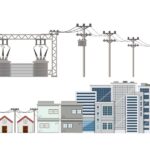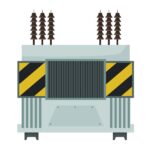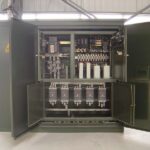Why must the neutral point of the transformer be grounded when it is shut down?
Answer: This is mainly a measure taken to prevent overvoltage damage to the transformer.
For a receiving transformer with power supply on one side, when its circuit breaker is not fully disconnected or closed, if its neutral point is not grounded, there are the following dangers:
(1) The neutral voltage to ground on the power supply side of the transformer can reach a maximum of the phase voltage, which may damage the transformer insulation.
(2) When there is capacitance between the high and low voltage windings of the transformer, this capacitance will cause “transfer overvoltage” from the high voltage to the low voltage.
(3) When the high-voltage and low-voltage windings of the transformer are capacitively coupled and the voltage on the low-voltage side reaches the resonance condition, a resonant overvoltage may occur, damaging the insulation.
For transmission transformers with power supply on the low voltage side:
(1) Because there is a power supply on the low-voltage side, single-phase grounding occurs on the high-voltage side of the transformer before it is connected to the system. If the neutral point is not grounded, the voltage between the neutral point and the ground will be the phase voltage, which may damage the insulation of the transformer.
(2) When not all phases are connected to the system, when one phase is connected to the system, due to the different frequencies of the generator and the system, and the neutral point of the transformer is not grounded, the maximum voltage between the neutral point of the transformer and the ground will be twice the phase voltage, and the voltage of the unconnected phase can be as high as 2.73 times the phase voltage, which will cause insulation damage accidents.
Most of the systems in my country above 110KV are directly grounded neutral point systems. The neutral point of the main transformer is equipped with a grounding switch. To ensure the sensitivity of the protection device, the neutral point grounding switch of the main transformer is often opened during operation. However, when the main transformer is operating, the grounding switch must be closed to prevent the overvoltage generated during operation from “affecting” the insulation of the main transformer.
Because the overvoltage caused by the asynchronous operation of the circuit breaker will endanger the insulation of these transformers, it is required to directly ground the neutral point of the transformer when cutting and closing the 110kV and above no-load transformer.
The transformer is an inductive component. After the voltage is instantly reduced, instantaneous high voltage will be generated inside it. For safety reasons, the neutral point is grounded.
What is the construction of transformer neutral point gap grounding protection?
Answer: The transformer neutral point gap grounding protection adopts the parallel connection of zero-sequence current relay and zero-sequence voltage relay with a 0.5S time limit. When a grounding fault occurs in the system, there is a zero-sequence current when the discharge gap discharges, which will cause the zero-sequence current relay of the special current transformer located at the grounding end of the discharge gap to operate; if the discharge gap does not discharge, the zero-sequence voltage relay will be used to operate. When intermittent arc grounding occurs, the time element shared by the gap protection shall not return halfway to ensure the reliable operation of the gap grounding protection.
When power is supplied to an unloaded transformer, must the neutral point of the transformer be grounded?
Answer: When power is supplied to an unloaded transformer, if the neutral point is not grounded, there will be the following dangers: ⑴ The voltage between the neutral point of the transformer power supply side and the ground can reach the phase voltage at most, which may damage the insulation of the transformer; ⑵ There is capacitance between the high and low voltage windings of the transformer, and this capacitance will cause “transmission overvoltage” of the high voltage to the low voltage; ⑶ When the capacitance between the high and low voltage windings of the transformer is coupled, a resonant overvoltage may occur, damaging the insulation. Therefore, when power is supplied to an unloaded transformer, the neutral point of the transformer must be grounded.
How are the arrangements for transformer neutral point grounding generally considered?
Answer: The arrangement of the transformer neutral point grounding method should try to keep the zero-sequence impedance of the substation basically unchanged. When encountering a special operating mode in which the zero-sequence impedance of the substation changes significantly due to reasons such as transformer maintenance, temporary handling should be carried out according to regulations or actual conditions.
1) If there is only one transformer in the substation, the neutral point should be directly grounded. When calculating the normal protection setting, only the normal operation mode of the transformer neutral point grounding can be considered. When the transformer is under maintenance, special operation mode can be used, such as changing the setting or stopping or starting the relevant protection stage according to regulations.
2) When there are two or more transformers in the substation, only one transformer should be directly grounded for operation. When the transformer is out of service, the other transformer with ungrounded neutral point should be directly grounded. If for some reason, the substation must have two transformers directly grounded for normal operation, when one of the transformers with directly grounded neutral point is out of service, if there is a third transformer, the third transformer should be directly grounded for operation. Otherwise, it will be handled as a special operation mode.
3) When there are three or more transformers in a double-bus operation substation, the two transformers should be operated in a neutral point direct grounding mode, and they should be connected to different buses. When one of the neutral point directly grounded transformers is out of service, the other neutral point ungrounded transformer should be directly grounded. If it is not possible to maintain a grounding point on each bus, it should be treated as a special operation mode.
4) In order to improve the protection coordination relationship, when a short line is shut down for maintenance, the number of neutral point grounding transformers can be increased to offset the impact of the line shutdown on the zero-sequence current distribution relationship.
5) The neutral point of autotransformers and transformers with insulation requirements must be directly grounded during operation.
How to operate the transformer neutral point grounding switch?
Answer: The switching principle is to ensure that the power grid does not lose its grounding point, and the operation method of closing first and then pulling is adopted:
- a) Close the isolating switch of the backup grounding point.
- b) Pull open the isolating switch at the working grounding point.
- c) Switch the zero-sequence protection to the transformer with grounded neutral point.
Why is the “make before break” method used when switching the neutral point grounding switch of the transformer?
Answer: Because the circuit breaker on the high-voltage side of the main transformer is generally operated in phases, the three-phase circuit breaker may not be closed or opened when opening or closing. This may cause zero-sequence overvoltage on the high-voltage side, which may be transmitted to the low-voltage side and easily cause damage to the insulation of the low-voltage winding. If the grounding disconnector is closed before operation, the overvoltage can be effectively limited and the insulation can be protected.
It is believed that “make before break” means that the protection is made before breaking, that is, if the neutral point switch of the main transformer is disconnected, the gap protection is closed first, and the zero-sequence protection is disconnected after the neutral point is switched on; conversely, if the neutral point switch of the main transformer is to be closed, the zero-sequence protection of the main transformer must be switched on first, and the gap protection must be disconnected after the neutral point is switched on. In short, the purpose is to prevent the busbar where the main transformer is located from losing grounding protection.
In a power grid with a directly grounded neutral point, under what circumstances is a lightning arrester installed at the neutral point of the transformer? What is its function?
A: In a power grid with a directly grounded neutral point, some transformers have ungrounded neutral points. When a three-phase lightning wave invades, the neutral point voltage is very high (up to 190% of the voltage amplitude at the incoming line). If the neutral point insulation is not designed according to the line voltage, a lightning arrester should be installed at the neutral point to limit the neutral point overvoltage amplitude and protect the neutral point insulation.
Why must the neutral point of 110KV and above transformers be grounded before power outage and power supply?
Answer: my country’s 110KV power grid generally adopts a neutral point direct grounding system. In operation, in order to meet the requirements of relay protection device sensitivity coordination, some transformers are operated without grounding their neutral points. However, because the overvoltage caused by the asynchronous operation of the circuit breaker will endanger the insulation of these transformers, it is required to directly ground the neutral point of the transformer when cutting and closing the 110KV and above unloaded transformer.
The number and location of neutral point grounding of transformers in operation should be set according to the requirements of relay protection, but the following should be taken into consideration:
① Insulation requirements of the transformer itself. ② In a high-current direct grounding system, at least one transformer should have its neutral point grounded on the power supply side (large phase-shifting transformers should be considered as power supply). 1. For a double-winding or three-winding transformer in operation, if it is a direct grounding system, if the switch on one side is disconnected, the neutral point grounding switch on that side should be closed. 2. If the neutral point grounding switch of a box-type transformer in operation needs to be switched, the neutral point grounding switch of another transformer should be closed first, and then the neutral point grounding switch of the original transformer should be opened. 3. When a transformer of 110kV or above is in hot standby mode (the transformer can be energized once the switch is closed), its neutral point grounding switch should be closed. 4. When a newly commissioned or overhauled transformer is put into operation, the phase should be determined, and if conditions permit, the voltage should be raised from zero as much as possible. Phase verification should be carried out for those that form a loop operation or need to close or release the loop.
Precautions for operation and running of transformer
- The conditions for parallel operation of box-type transformers are: the same wiring group, the same transformation ratio, and the equal short-circuit voltage.
- When the transformer is put into operation, the side with less influence of excitation inrush current should be selected for power supply. Generally, charge from the power supply side first, and then close the load side switch. When the power is off, the load side switch should be opened first, and then the power supply side switch.
- When charging the transformer, please note:
① The charging switch should have complete relay protection and ensure sufficient sensitivity. At the same time, the impact of excitation surge current on system relay protection should be considered.
② To prevent the system from becoming unstable after the charging transformer fails and trips, the active power of the relevant lines can be reduced if necessary.
③ In the high-current directly grounded system, the neutral point grounding switches on both sides of the transformer should be closed.
④ Check the power supply voltage to ensure that the voltage on each side of the transformer does not exceed 5% of its corresponding tap after charging.







